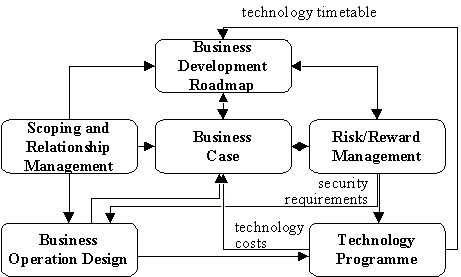
 |
planning collaborationveryard projects > planning > collaboration |
| we offer | planning issues | material | links | ||||
| consultancy
management briefings independent advice on tools and methods |
Many large and complex
schemes
today are characterized by:
|
Our Planning Approach | |||||
|
The logic of the business case is developed through a
series of interconnected models.
|
 |
Our Planning Approachveryard projects > planning > collaboration > approach |
Scoping and relationship managementBusiness operation designTechnology programmeRisk/reward managementBusiness development roadmapBusiness case |
 |
Sometimes it is quicker to start a scheme with a relatively small number of committed players, and then allow others to join later. But this leaves a potential for conflict when the scheme is expanded later.
Key issues here include the packaging of services and the basis for cross-charging. In some schemes, such arrangements will be governed by market forces; in other schemes, they will be governed by agreement between the members of the scheme, or by an external regulator.
We expect key requirements such as security to be designed into the operational network. Although there is a role for technical security mechanisms, it is bad design practice simply to bolt these on as an afterthought.
Responsibility for technical development and customization is typically allocated to members of the scheme. Some coordination will be required at the programme level.
Technical costs are dependent on the expected scale of operations, as well as the timing of requirements. Procurement of technology should be managed to balance the risk of premature expenditure against the risk of inadequate capacity. While this is a familiar problem for technology planners, new complications arise when the planning involves many collaborating parties.
Traditional approaches to risk management are disconnected from management of benefits. We need to recognize that some stakeholders will be able to carry a greater share of the risk, in return for higher rewards.
The roadmap shows the risk/reward equation that is applicable at each stage, and the likely take-up of the benefits of the scheme. Early stages of the scheme may be designed for a small number of early adopters – the roadmap needs to indicate how the scheme will subsequently be disseminated to a larger population of users.
A complex scheme typically provides multiple sources of value. These sources of value interact with one another – either positively (which we call the "multiplication scenario") or negatively (which we call the "interference scenario").
Programme management is then focused on promoting the multiplication
scenario and avoiding the interference scenario.
| Business Case Models |
![]()

|
 |